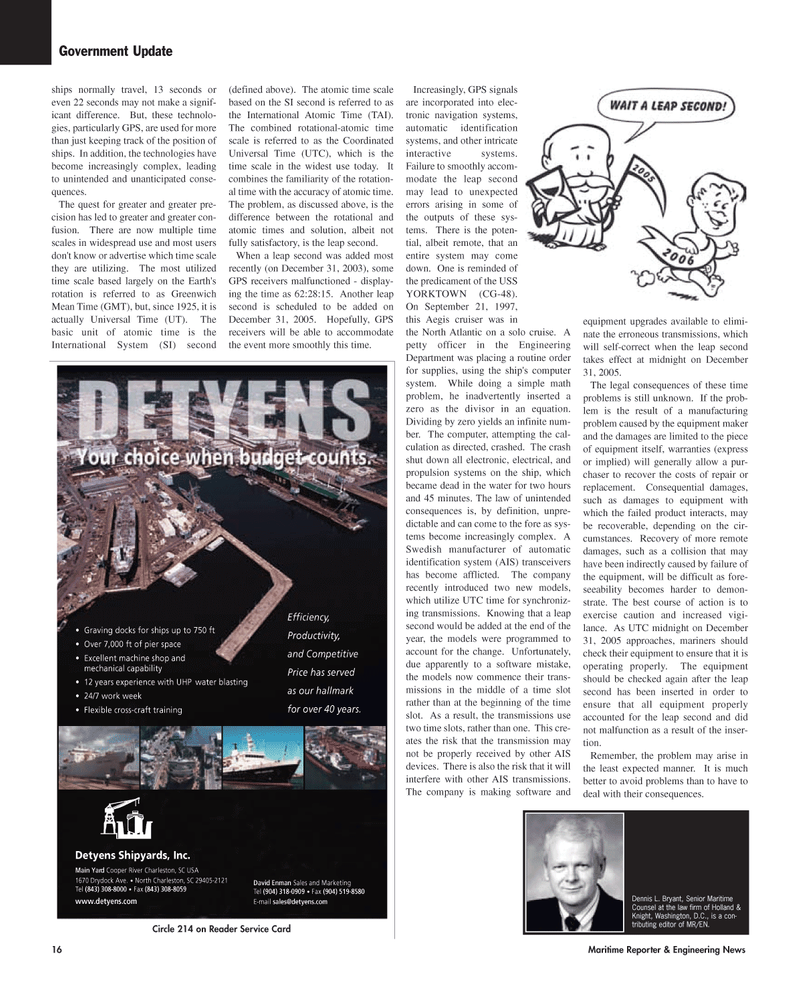
Page 16: of Maritime Reporter Magazine (December 2005)
Great Ships of 2005
Read this page in Pdf, Flash or Html5 edition of December 2005 Maritime Reporter Magazine
16 Maritime Reporter & Engineering News ships normally travel, 13 seconds or even 22 seconds may not make a signif- icant difference. But, these technolo- gies, particularly GPS, are used for more than just keeping track of the position of ships. In addition, the technologies have become increasingly complex, leading to unintended and unanticipated conse- quences.
The quest for greater and greater pre- cision has led to greater and greater con- fusion. There are now multiple time scales in widespread use and most users don't know or advertise which time scale they are utilizing. The most utilized time scale based largely on the Earth's rotation is referred to as Greenwich
Mean Time (GMT), but, since 1925, it is actually Universal Time (UT). The basic unit of atomic time is the
International System (SI) second (defined above). The atomic time scale based on the SI second is referred to as the International Atomic Time (TAI).
The combined rotational-atomic time scale is referred to as the Coordinated
Universal Time (UTC), which is the time scale in the widest use today. It combines the familiarity of the rotation- al time with the accuracy of atomic time.
The problem, as discussed above, is the difference between the rotational and atomic times and solution, albeit not fully satisfactory, is the leap second.
When a leap second was added most recently (on December 31, 2003), some
GPS receivers malfunctioned - display- ing the time as 62:28:15. Another leap second is scheduled to be added on
December 31, 2005. Hopefully, GPS receivers will be able to accommodate the event more smoothly this time.
Increasingly, GPS signals are incorporated into elec- tronic navigation systems, automatic identification systems, and other intricate interactive systems.
Failure to smoothly accom- modate the leap second may lead to unexpected errors arising in some of the outputs of these sys- tems. There is the poten- tial, albeit remote, that an entire system may come down. One is reminded of the predicament of the USS
YORKTOWN (CG-48).
On September 21, 1997, this Aegis cruiser was in the North Atlantic on a solo cruise. A petty officer in the Engineering
Department was placing a routine order for supplies, using the ship's computer system. While doing a simple math problem, he inadvertently inserted a zero as the divisor in an equation.
Dividing by zero yields an infinite num- ber. The computer, attempting the cal- culation as directed, crashed. The crash shut down all electronic, electrical, and propulsion systems on the ship, which became dead in the water for two hours and 45 minutes. The law of unintended consequences is, by definition, unpre- dictable and can come to the fore as sys- tems become increasingly complex. A
Swedish manufacturer of automatic identification system (AIS) transceivers has become afflicted. The company recently introduced two new models, which utilize UTC time for synchroniz- ing transmissions. Knowing that a leap second would be added at the end of the year, the models were programmed to account for the change. Unfortunately, due apparently to a software mistake, the models now commence their trans- missions in the middle of a time slot rather than at the beginning of the time slot. As a result, the transmissions use two time slots, rather than one. This cre- ates the risk that the transmission may not be properly received by other AIS devices. There is also the risk that it will interfere with other AIS transmissions.
The company is making software and equipment upgrades available to elimi- nate the erroneous transmissions, which will self-correct when the leap second takes effect at midnight on December 31, 2005.
The legal consequences of these time problems is still unknown. If the prob- lem is the result of a manufacturing problem caused by the equipment maker and the damages are limited to the piece of equipment itself, warranties (express or implied) will generally allow a pur- chaser to recover the costs of repair or replacement. Consequential damages, such as damages to equipment with which the failed product interacts, may be recoverable, depending on the cir- cumstances. Recovery of more remote damages, such as a collision that may have been indirectly caused by failure of the equipment, will be difficult as fore- seeability becomes harder to demon- strate. The best course of action is to exercise caution and increased vigi- lance. As UTC midnight on December 31, 2005 approaches, mariners should check their equipment to ensure that it is operating properly. The equipment should be checked again after the leap second has been inserted in order to ensure that all equipment properly accounted for the leap second and did not malfunction as a result of the inser- tion.
Remember, the problem may arise in the least expected manner. It is much better to avoid problems than to have to deal with their consequences.
Circle 214 on Reader Service Card
Efficiency,
Productivity, and Competitive
Price has served as our hallmark for over 40 years. • Graving docks for ships up to 750 ft • Over 7,000 ft of pier space • Excellent machine shop and mechanical capability • 12 years experience with UHP water blasting • 24/7 work week • Flexible cross-craft training
Detyens Shipyards, Inc.
Main Yard Cooper River Charleston, SC USA 1670 Drydock Ave. • North Charleston, SC 29405-2121
Tel (843) 308-8000 • Fax (843) 308-8059 www.detyens.com
David Enman Sales and Marketing
Tel (904) 318-0909 • Fax (904) 519-8580
E-mail [email protected]
Government Update
Dennis L. Bryant, Senior Maritime
Counsel at the law firm of Holland &
Knight, Washington, D.C., is a con- tributing editor of MR/EN.
MR DECEMBER2005 #2 (9-16).qxd 11/30/2005 11:02 AM Page 16

 15
15

 17
17
